Are you suffering from PANCAKE BUTT?!! hehe
Ok I’d never heard this term before a Facebook Live “Ask Me Anything” when I got asked about the best moves for a “pancake butt.”
I found the expression incredibly amusing, but it also got me to thinking about the science behind developing shapely, strong glutes.
How could you best develop them and create the perky shape you wanted?
A. You would need to create a program implementing all 3 drivers of muscle growth.
B. You would need to combine movements in a variety of planes of motion to not only target all three glute muscles, but even different aspects of those muscles.
And C. You would need to focus on not only adding loads or weight but different types of resistances and a variety of reps and set schemes.
First let’s go over the different drivers of muscle growth and the different ways to target different aspects of the glutes.
Then I’ll share 5 Must-Do Moves To Avoid The Dreaded Pancake Butt!
The 3 Drivers Of Muscle Growth:
Too often we think the only way to “grow” a muscle or promote muscle hypertrophy is through using heavier loads and creating a ton of muscle tissue damage aka lifting heavy and making ourselves really sore with moves like the squat and deadlift.
BUT muscle tissue damage is only ONE driver of muscle growth.
And SORENESS? Well soreness isn’t an indicator of progress or results.
Soreness can simply even mean you did something new (or even that your hydration or sleep aka your recovery is off). So stop using soreness as your indicator that you worked hard enough!
And especially as you utilize metabolic stress, and potentially even more moves that create mechanical tension, to get results, you may even find there are workouts you feel a huge pump DURING the actual workout and NOTHING after. No soreness. NOTHING.
That’s not a bad thing!
We don’t always need to use heavy loads and compound moves with huge ranges of motion to get results. They are just one piece of the puzzle.
So what are the 3 drivers of muscle growth?
- Muscle Tissue Damage
- Mechanical Tension
- Metabolic Stress
Let’s start by reviewing what moves create the most muscle tissue damage as these are the moves we tend to think are most important for results.
Muscle Tissue Damage:
If you’ve ever heard “Squat for a better butt,” you may have fallen victim to the belief that if you just squat, you’ll get rid of your pancake butt.
However, squats alone may NOT get you the results you were hoping for.
Neither may deadlifts or lunges even.
While these compound moves are ESSENTIAL to include in your routine, there is no “one best move” out there that alone will get you results.
And thinking there is, will only hold you back from using every tool in your toolbox to get the best results as fast as possible.
These compound moves, done with challenging loads, create more muscle tissue damage, which can drive muscle growth.
If you break down muscle tissue and recover proper, your muscles should grow stronger and bigger in response.
HOWEVER, the more muscle tissue damage you create, the longer you have to rest before working the muscle again so that it actually recovers and rebuilds.
If you don’t let the muscle rebuild and recover, you’re constantly just tearing it down which will fight against all of your hard work.
If you’re constantly only doing heavy lifts and the volume is adding up with those, you probably are only able to train that muscle effectively once a week. And this isn’t ideal.
Studies have shown that the optimal training frequency for muscle hypertrophy may actually be 2 to even 3 times a week. So if you want to shape up that pancake butt, adding in a second glute day each week may be the answer!
You can’t increase your training frequently though if you’re constantly creating extreme amounts of muscle damage.
While controlling overall volume can definitely help, so can using moves that drive growth in other ways.
But first, what moves create more muscle tissue damage?
Moves that will create more muscle tissue damage:
- Have moderate glute activity
- Big ranges of motion
- Peak tension when the glutes are lengthened
- Emphasize the eccentric
These are most often those big compound lifts like squats, deadlifts, and lunges that we tend to load down.
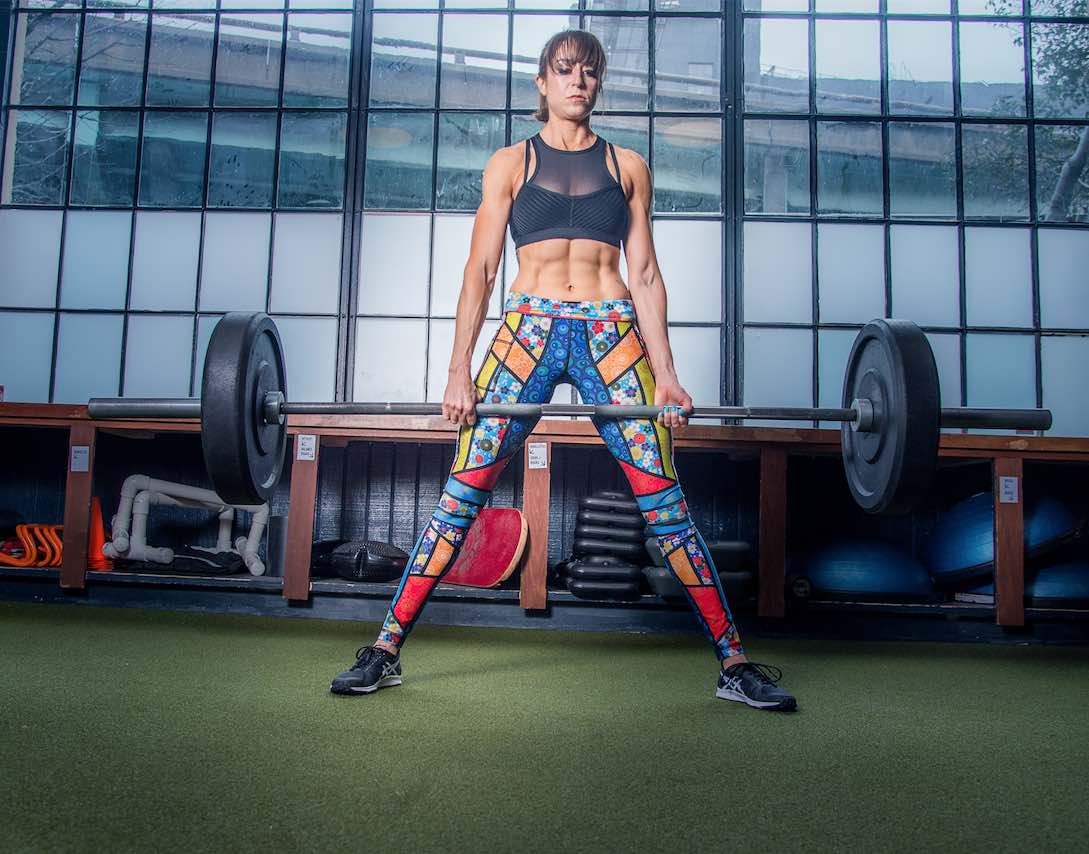
Many of these moves focus primarily on the glute max, working that lower glute max just slightly more.
These moves can be included in your workouts as some of your primary lifts, using moves that may create less damage and be done with lighter loads for slightly higher reps after.
Or you may even include them on your leg day with a separate “glute day” each week that focuses on those glutes with moves that create less muscle damage.
With these compound moves, you may work on maximal strength in the 1-5 rep range or even work in the more traditional hypertrophy range of about 6-12 reps.
You want to make sure to use a weight that challenges you though for whatever reps you select!
And you can even create more muscle damage by not only increasing the loads, but by changing the tempo of your reps.
Especially if you slow down the ECCENTRIC portion of the move, you can create more damage. (This would mean slowing down the lower down in the squat or the lunge for example.)
More time under tension, and especially more of a focus on the eccentric, means more work for those muscles.
This can be another great way to advance movements if you don’t necessarily have heavier loads or want to do more reps!
Mechanical Tension:
If you do a chest exercise and expect your glutes to grow, you’re going to be waiting a long time.
Why? Because you placed no tension on the muscle you wanted to work!
Seems sort of silly and obviously, right?
But that is what mechanical tension is…placing more tension on the muscle you want to work!
So if you want to work your glutes, the more tension you place on that muscle, the more you can drive growth.
Now all too often we simply try to “add weight” to create more tension.
But with our glutes, this can backfire.
Using our “mind-body connection” to better recruit the muscle, while using moves that place the most tension on the muscle when shortened, may actually allow us to create more tension with LIGHTER loads!
Now this doesn’t mean you shouldn’t still CHALLENGE yourself.
But it does means that instead of depending on the LOAD to challenge the muscle, you need to focus on the muscle you FEEL working and try to activate it as much as possible with your MIND.
You want to THINK about it contracting hard.
The reason for this is that, with the glutes specifically, simply going heavier with some moves may actually lead to synergists doing more work to lift instead of the glutes coming under more tension.
So if you do that barbell hip thruster and start to feel your quads and hamstrings working more as you increase loads, you may actually be going “too heavy” to create the optimal amount of muscle tension in your glutes!
Basically, adding a heavier load only works to an extent and there is a point for each of us when going heavier fights against us optimally engaging and recruiting the muscle we want.
What glute moves create the most mechanical tension?
Moves that:
- Have high glute activity
- Moderate ranges of motion
- Peak tension when the glutes are shortened
- Can emphasize the eccentric
These moves can be more isolated or still compound lifts.
They are moves like the barbell hip thruster, the back extension, high step ups, ankle weight abductions and cable kickbacks.
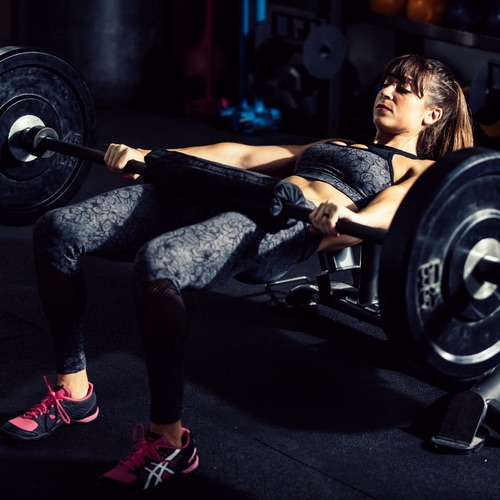
The variety of moves that create mechanical tension allow you to work not only your entire glute max, but also really target your glute medius. And many of the abduction movements even allow you to hit that upper glute max a bit more, which can help get rid of that “pancakedness.”
These moves generally don’t take as long to recover from (usually about 2-3 days), which can make them great to include to really perkify that butt while increasing your training frequency.
Most often these moves will be done for about 5-15 reps. Some moves like the barbell hip thrusters may be done with heavier weights so you may work down in reps; however, just make sure this isn’t necessarily at the expense of FEELING the correct muscle driving the movement. (Make note of your personal set point where synergists may start to dominate.)
Because lighter loads may allow for you to focus more on your glutes working, you may find you often work between 10-15 reps with these moves.
NOTE: Range of motion is still important and so are even the TOOLS used with these moves. Start to shrink the range of motion on some of these moves and you get into creating more metabolic stress territory!
Metabolic Stress:
You know that feeling when you’ve done a band move and you stand up and grab your butt and think “Holy butt cheeks batman!?”
That feeling right there, that “burning sensation,” is called metabolic stress.
These moves make great activation exercises prior to your heavy lifts and runs to help you make sure your glutes are working.
Because you can do a few to create that “pump” and establish that mind-body connection, without wearing yourself out, they can help you make sure your recruitment patterns are correct when you go into more compound movements.
That makes many of these moves great rehab/prehab movements to avoid injury!
However, ONLY using these moves as activation exercises doesn’t allow you to take full advantage of their metabolic stress benefit!
Following a compound movement with a more isolated exercise to create a pump can help you further burnout a muscle.
They also make great burnouts to target those glutes even at the end of a leg day with compound moves!
You may even find that doing full circuits or workouts with these moves can allow you to dramatically increase your training frequency without the need for extended recovery.
Most of these moves you will feel a lot at the time yet the next day feel like you could train again. Their recovery cycle is much shorter, making them a key piece to include to maximize your results.
And they can be a great way to really utilize that mind-body connection to build and tone your glutes.
Especially for runners or cyclists who don’t want to risk the “soreness” or “fatigue” of heavy lifting affecting their training, these are a great way to build and strengthen their glutes!
Moves that will create metabolic stress:
- Have LOW glute activity
- Small ranges of motion
- Peak tension when the glutes are shortened
- Varied tension on the muscle
Wait…LOW glute activity?!
You may now be thinking, “Then why are they great as activation moves to establish that mind-body connection if they have LOW glute activity!? And why the heck do I feel them burn so much!?”
The reason these moves are AMAZING activation exercises all comes down to the fact that they DO create that PUMP and that BURN.
Even think about it in terms of your biceps after curls. When you feel that muscle with a PUMP, your brain is much more aware of that muscle with every other move, right!?
By using these moves to create that pump and burn, you help your brain to really FEEL the muscle, which is what establishes that mind-body connection.
And while it may seem strange they have lower glute activity, the pump you feel isn’t so much due to the activation of the muscle, but the fact that you restrict blood flow out of the muscle.
By keeping the glutes under constant tension with quick back to back reps you prevent blood from leaving the muscle aka your cells swell, you get pumped and create metabolic stress.
And that “burn?” Well that is due to the build up of certain metabolites that happens due to the constant tension for that higher volume!
So what moves create metabolic stress?
Think about all of those amazing band moves!
Band monster walks, band side shuffles, band glute bridges, frog bridges, clams, fire hydrants…all are great moves to create that pump!

With most of these moves, you will want to focus less on increasing the resistance and more on the VOLUME. Reps for these will usually be in that 15-30 rep range.
Yup…30 reps even.
Beginners may find it even takes more reps at first to establish that mind-body connection while more advanced exercisers can engage from that first rep and really build up that burn!
These moves are also a great way to target your glute medius especially while working your entire glute max. And by using some of the abduction moves, you can even target that upper glute max more if needed.
And if you want to focus a bit more on that lower glute max?
Why not try creating metabolic stress with some of those moves that usually create more muscle tissue damage….
Wait…How can you do that?!
Change The Resistance, Change The ROM, Change The Driver?!
If we want results, we need to progress our workouts. We need to progress our movements.
To do this, we usually add more weight or do more reps.
But sometimes using slightly different VARIATIONS of movements is actually the key to progressing our workouts so that we can keep moving forward.
By using the “same but different,” or variations of moves we usually love even with “LESS” weight, we can also change how they drive muscle growth.
For instance, a barbell hip thruster will create more mechanical tension.
But what if you used a band instead of a bar AND added a mini band or booty band around your legs?
If you changed the equipment in this way, you could take a move that usually would create more muscle tension and use it to create more metabolic stress!
It’s the same move, but by changing the resistance, you change how the move drives growth.
By replacing the barbell with bands, you place less of a focus on the eccentric portion as the band reduces tension as you come back toward the anchor point.
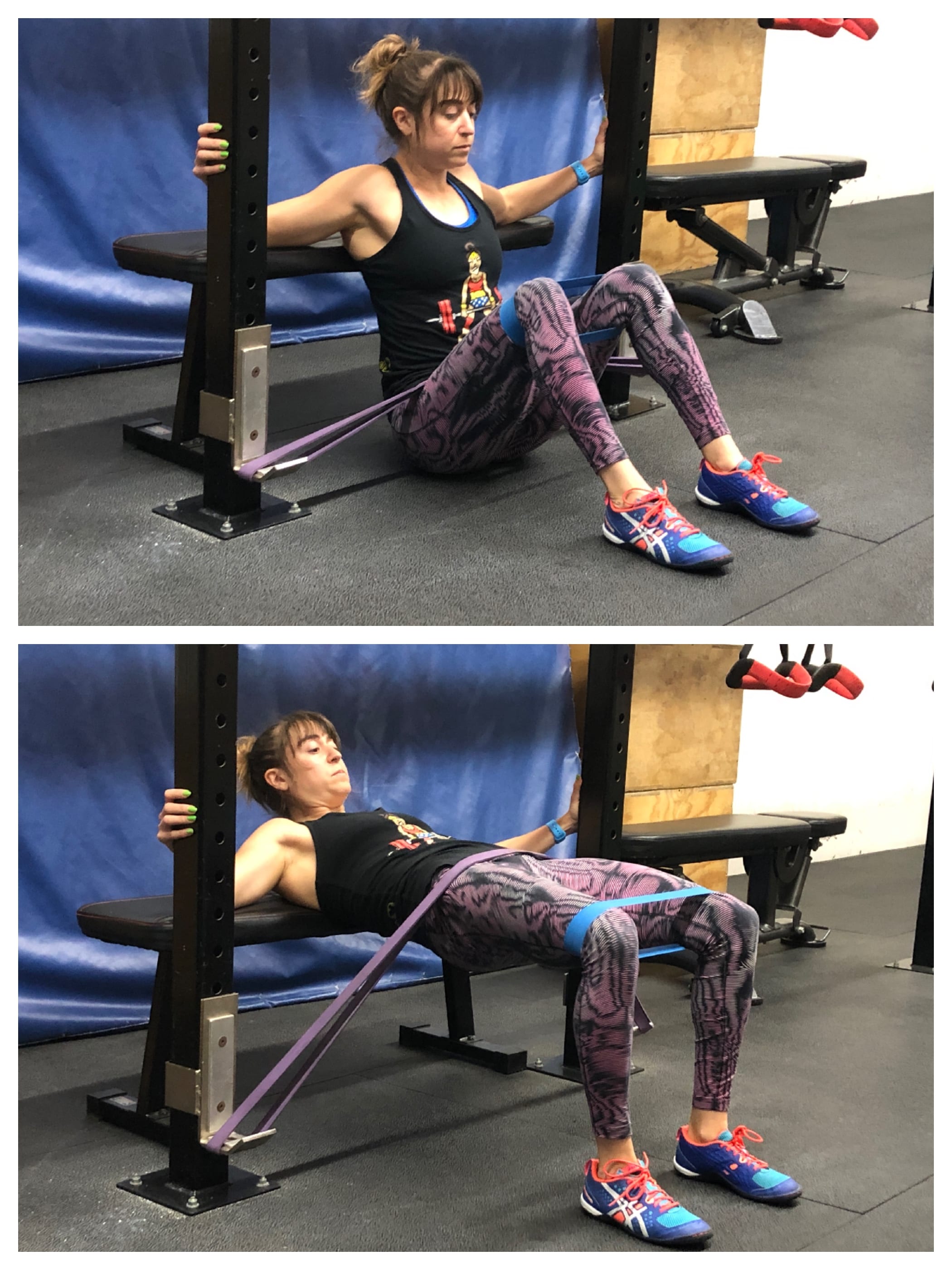
And by using the mini band, you put the glute medius under constant tension, which then helps build more of a pump!
But it’s not just a change in tools that can take a move from creating a ton of muscle tissue damage to more metabolic stress.
You can also change the range of motion!
Take that basic squat.
You can load it down and create a ton of muscle damage.
OR you can place a band around your legs and shrink the range of motion, pulsing only at the bottom or even coming just short of lockout.
By changing the squat so the range of motion is smaller and you’re CONSTANTLY under tension, you will create that pump instead!
Using different variations of the squat may not be a clear “progression” but this same but different movement may just be what you need to keep progressing and challenging your body!
Sometimes it can even simply be a slightly different body position during the movement that will keep you moving forward.
Take for instance the mini band seated abduction. You can do these seated on the ground or off a bench. While seated on the bench, you can lean forward or backward or sit up nice and tall.
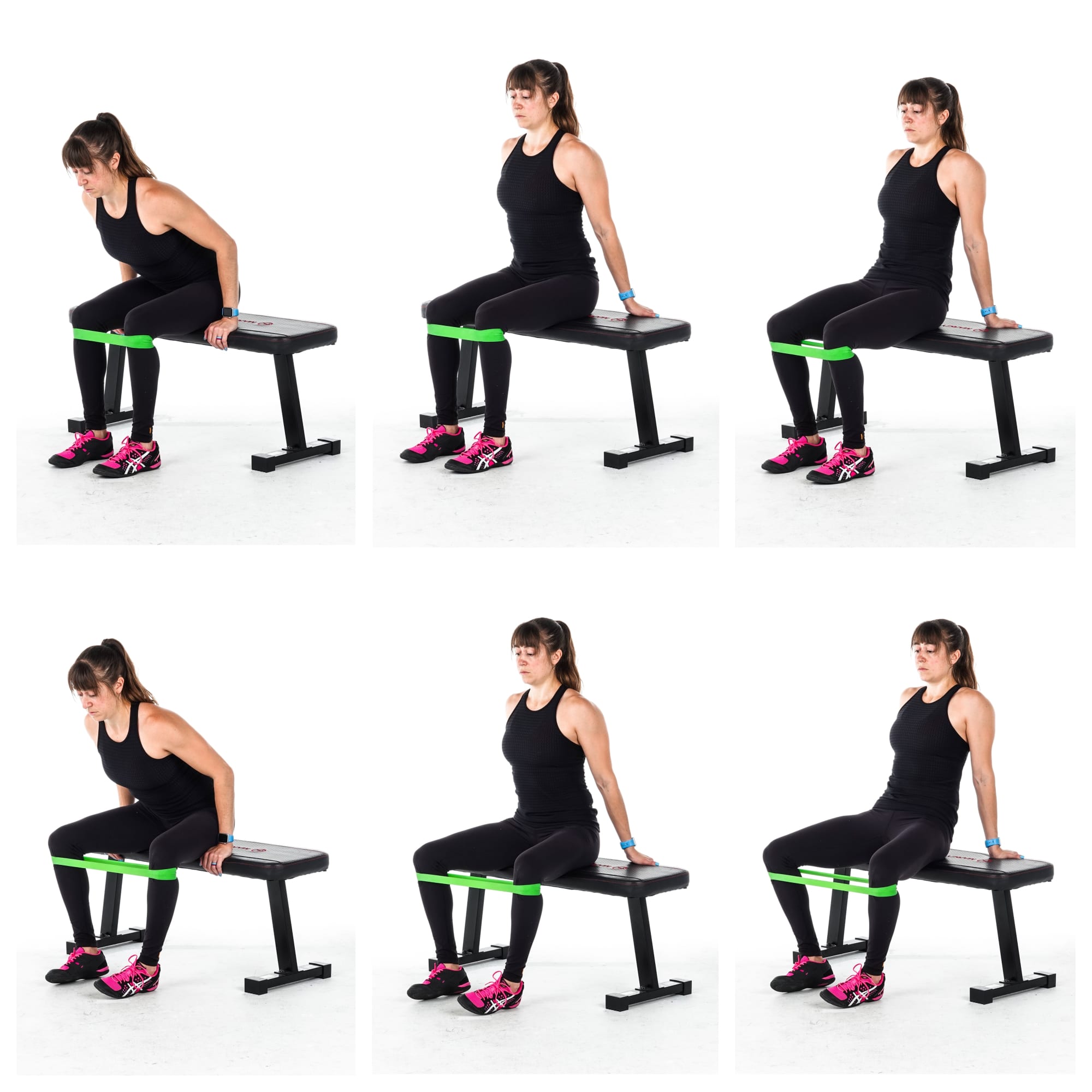
All of these involve slightly different angles of hip flexion which can affect not only where you feel it but how much you target the anterior or posterior fibers of your glute medius!
This seemingly slight difference can be a way to progress movements so you are really working those glutes from every angle for the best results possible!
5 Must-Do Moves To Avoid The Dreaded Pancake Butt:
Now the fun stuff hehe
These 5 moves cover all 3 drivers of muscle growth and work your glutes from every angle.
They will target not only your entire glute max, but also your glute medius.
And if you need to focus more on your upper glute max or lower glute max to build that round, perky butt, these will also help you out!
Band Squat Pulses:
If you want to use metabolic stress to build those glutes, this is a great version of the squat to include. You will want to use it for between 15-30 reps aka a higher rep range without focusing on upping the resistance.
The Band Squat Pulse will target your glute medius as well as your entire glute max.
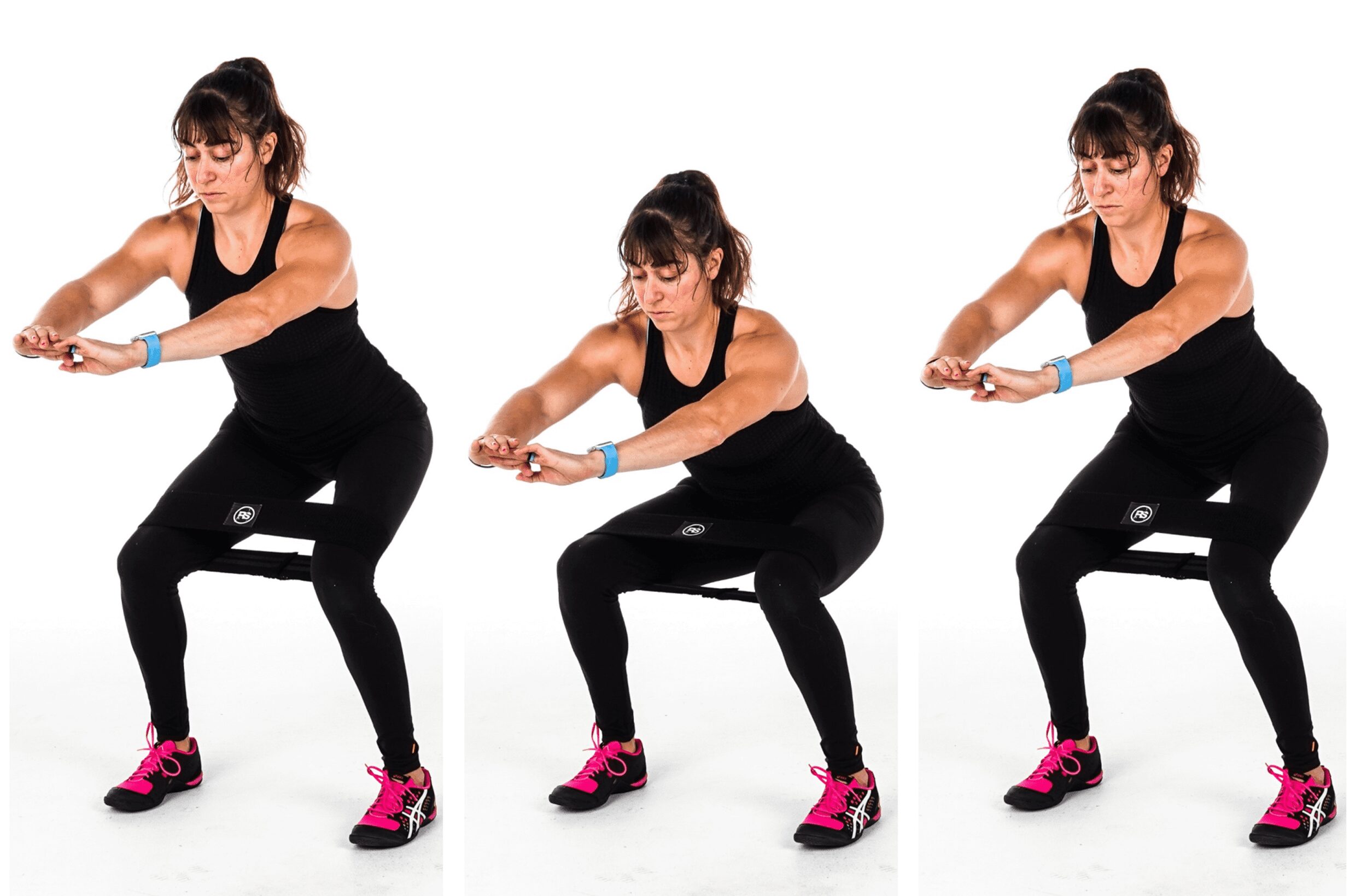
To do Band Squat Pulses, place the booty band or mini band around your legs above your knees (or if using a mini band, below your knees even) and stand with your feet about hip-width apart.
Sit back and down, pressing your knees out against the band so your ankles, knees and hips stay in line. You do not want your knees to cave in.
Sink to about parallel to the ground and then pulse a few inches up and down from here. You do not want to start below parallel and you don’t want to stand fully up as you pulse. You want the range of motion to be about 6 inches around that parallel position.
Once all pulses are complete, stand up.
Make sure your knees don’t cave in as you pulse and that your heels stay down and feet are flat on the ground. Do not round over. Make sure to keep your back flat and chest up.
Beginners may pulse over a bench or even hold on to help them balance. You can also stay up higher in the pulse squat instead of sinking as low.
You can also even vary this movement by performing a GOBLET band pulse squat, holding a dumbbell or kettlebell up at your chest. Or by changing the exact range of motion performed!
Barbell Hip Thrusters:
This move will create muscle tension to work those glutes and target the entire glute max.
As you progress, you will want to add loads, just be careful that you don’t start allowing your hamstrings and quads to take over just so you can go heavier.
Advanced exercisers able to go heavier may work down toward 5 reps while beginners or anyone really wanting to focus on that mind-body connection may find they need to stay in that 10-15 or even 20 rep range!

To do the Barbell Hip Thruster, set up a bench and make sure it won’t move as you bridge up with your back on it. Take a barbell and put some padding around it so that it won’t dig into your hips as you perform the move.
Place your upper back against the bench and sit with your butt on the ground and your legs out straight. Roll the barbell up over your hips and then bend your knees and plant your feet firmly on the ground and close to your butt. Your mobility may dictate the exact placement of your feet.
Holding the bar firmly, drive up through your heels and your upper back on the bench, to lift your butt up off the ground and drive your hips, and the barbell, up toward the ceiling.
Squeeze your glutes and press your hips up as high as possible, driving the barbell up and off the ground. Hold a second or two at the top and then lower back down and repeat.
Do not hyperextend your back at the top. Really squeeze your glutes at the top and even posteriorly tilt your pelvis. Make sure you are driving straight up through your heels. Do not push yourself backward over the bench.
You may find that as you bridge up you want to “push” the barbell down toward your thighs to help you drive up and squeeze your glutes.
You can also slightly keep your chin tucked so you’re looking up but out past your legs instead of relaxing your head back to look straight up at the ceiling. This little flexion of your neck can help with your glute engagement.
Lower your butt back down toward the ground and repeat.
You do not fully need to touch the weight down, but you do want to complete a full range of motion. Make sure to sit back forward as you lower down instead of trying to keep your upper back up on the bench so that you don’t hyperextend your back by simply lowering your butt.
Then repeat, driving your hips back up.
Do not rush the movement. While you can add weight to make the movement harder, you may also want to adjust the tempo!
Slowing down the lower down can create more tension on that muscle too! It’s not always about adding loads!
Band Lying Lateral Raises:
This is a great move to create metabolic stress, strengthen your glute medius and even target your upper glute max more!
Especially if you’re a runner, this is a must-do move for hip stability and a great way to “perkify” your butt while not creating fatigue for your running!
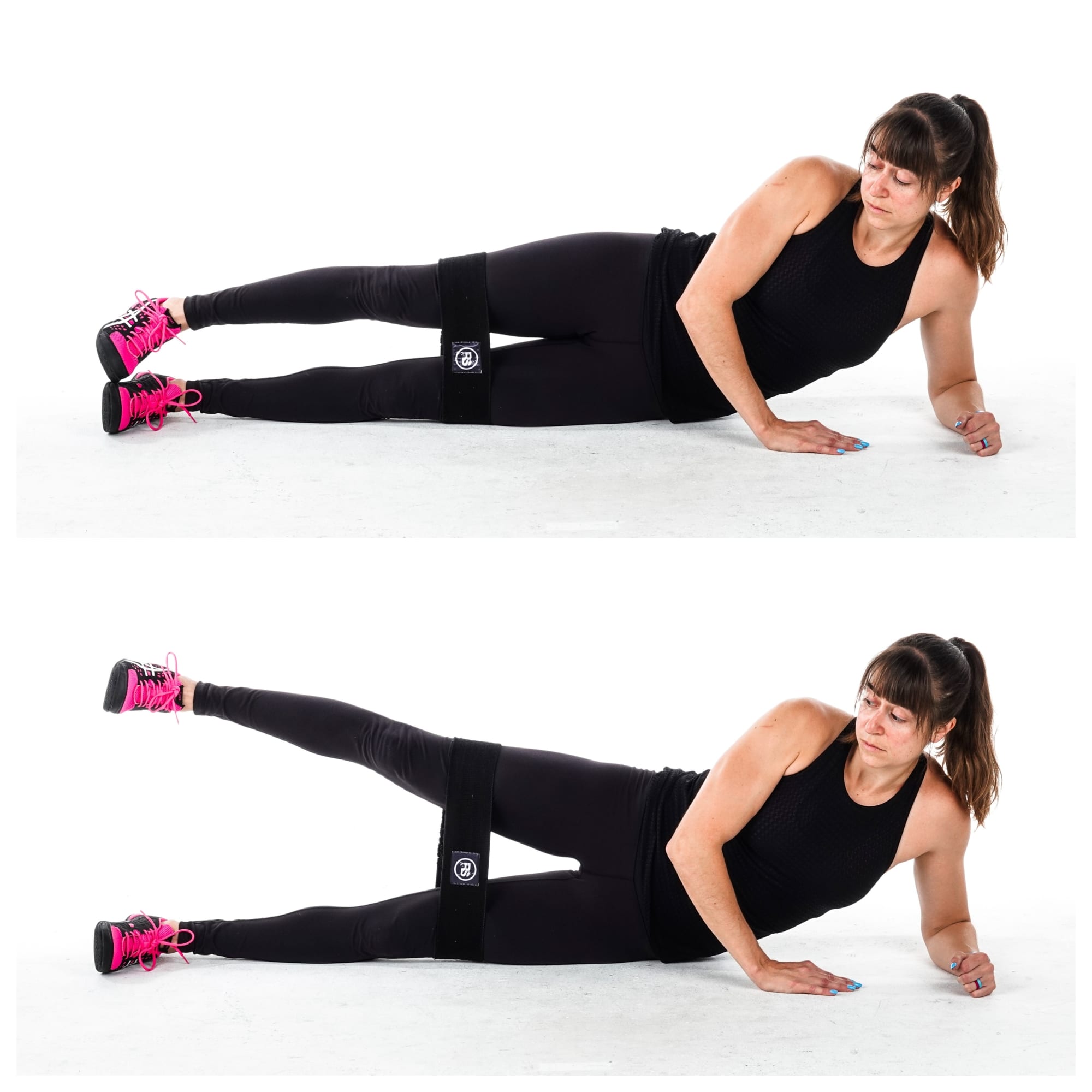
To do Band Lying Lateral Raise, place the band around your legs. The placement depends on the band and how well you can engage your glutes. Put it above your knees if you’re using a booty band or heavier mini band or below your knees to progress the movement using a mini band. You can even move the band down around your ankles if you don’t feel other muscles compensating.
Then lie on your side on the ground. You can support your head in your hand while lying on your side or relax fully onto your side. Place your top hand on the ground in front of you to help you stabilize.
Stack your feet on top of each other and then lift your top leg up so there is just a very little bit of tension on the band. If you have a booty band, you may not really have to lift it, but just make sure there is tension and you keep this tension throughout!
Then lift your leg straight up toward the ceiling as high as you can without rotating your toe up. Do not rock or swing to lift up higher. If you can only lift a few inches up higher that is fine. It’s better to do the range of motion you can control.
If you struggle to feel your glutes and instead feel your hips, kick slightly back as you lift up or turn your toe down toward the ground to internally rotate your hip.
Quickly perform reps, keeping tension in the band the entire time.
Deficit Reverse Lunge:
One way to progress a movement is by adding load. Another is by changing up the tempo.
A third is to INCREASE the range of motion.
Not only will this help you create more muscle tissue damage but it will also help you strengthen through a bigger range of motion to improve your mobility.
However, this only works if you ACTUALLY work through the increased range of motion. If you can’t lunge all the way to the ground with a standard reverse lunge, you aren’t ready for the deficit version.
While this move will work your entire glute maximus, it will hit that lower glute max harder!
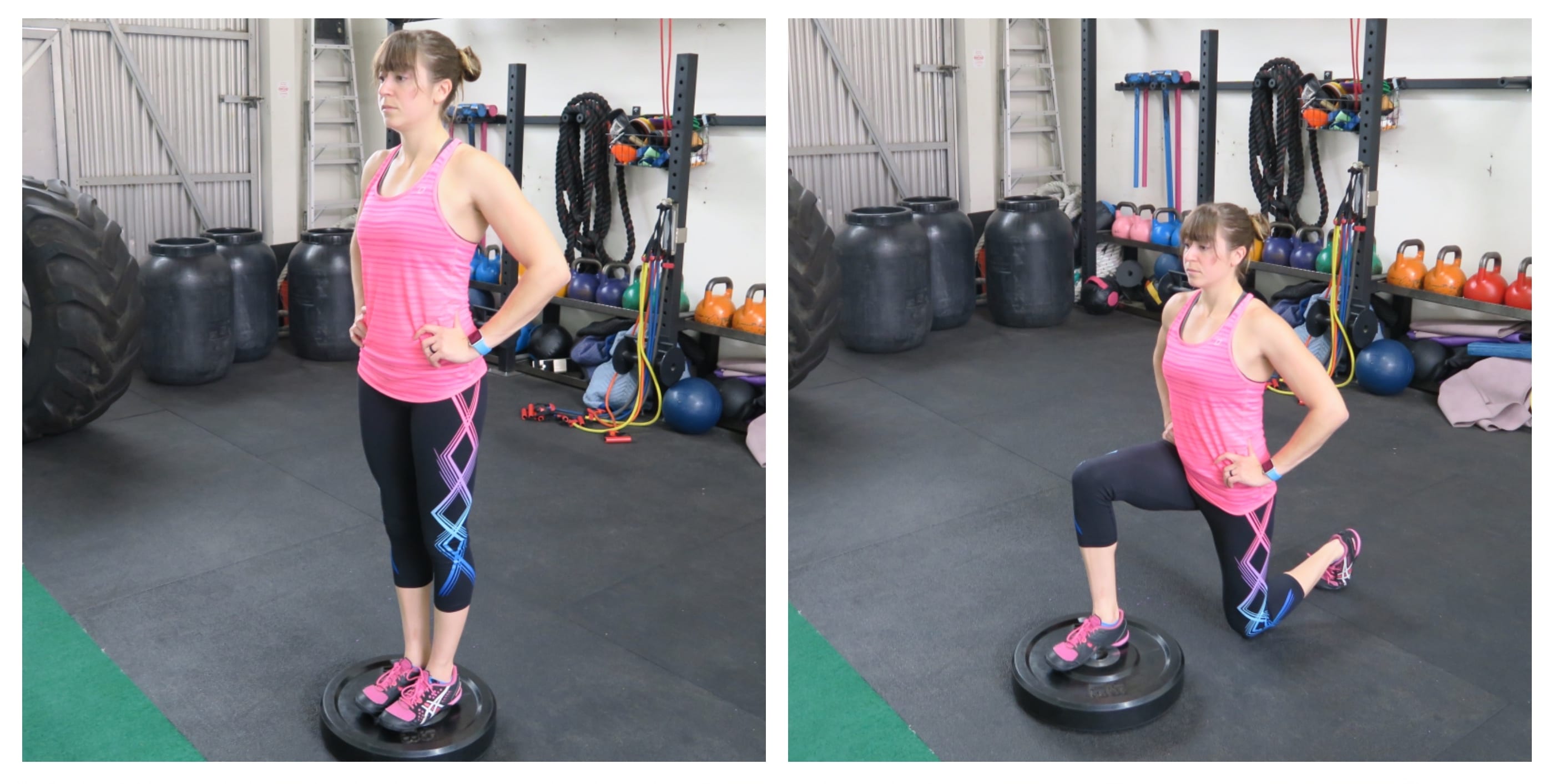
To do Deficit Reverse Lunges, set a small box or stack of stable plate weights on the ground. Even just starting with a single 45lbs bumper plate is enough to make a difference.
If you’re ready, add weights but start with making sure you can complete the full range of motion.
Stand tall and then step back off the box or weight, bending your front knee to about 90 degrees as you drop your back knee down to lightly touch the ground or hover right over it.
Really sit back in that front heel as you sink down.
Keep your chest up and do not hunch or round over. While you may hinge slightly at your hips to sit back and load the glute, you should maintain a nice neutral spine.
Then drive back up to standing on the box by pushing through that front heel.
Don’t lean or rock forward but think about driving straight up to standing. Then lunge back again.
If you can’t get your knee down past the platform and close to the ground, you aren’t yet ready for the increased range of motion.
Band Seated Abductions:
This is a great move to work your glute max and medius with a slight bit more “love” for that upper glute max.
This move is a great way to create that glute pump.
And there are so many little tweaks you can make to this move to implement that “same but different” rule to help you progress!
You can change your body positioning from standing to seated. You can even change how much you lean backward or forward while seated to work those glutes in different ways!
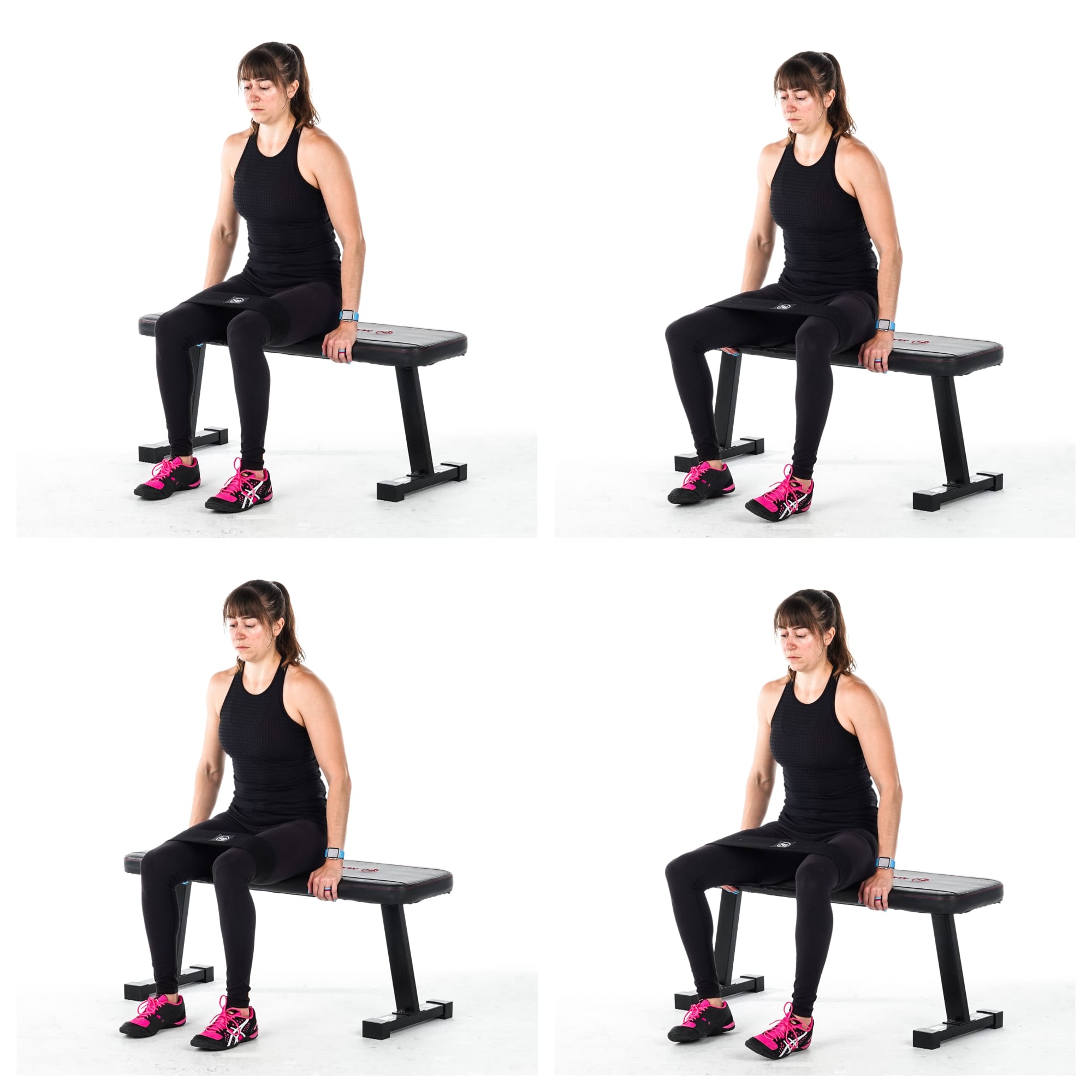
To do the standard Band Seated Abductions off a bench, place the mini band right below (more advanced) or right above (a bit easier) your knees. If you’re using a booty band, place it above your knees. Whichever place you choose or whatever weight mini band you use, just make sure you feel your glutes and outside your hips actually working.
Sit up nice and tall with your hands on the edge of the bench and your feet about hip-width apart. Then press your knees open against the band as you sit up tall. Really use your glutes to press the band open.
Do not slouch or rock back. Press your hips forward as you press your knees open. You may rock open on your feet, but don’t simply rock and bend your ankles. Really press the band open with your knees.
You MAY lean back or forward just make sure this is a CONSCIOUS change in placement instead of swinging as you do the move!
Using these tips and 5 moves, you can build a round, perky booty and reverse that pancake butt!
Want more amazing workouts to help you build your leanest, strongest body ever?




Thank you!
You really nailed the pancake butt which in turn should help with the sleepy a**!
I read your email diligently and have learned so much. Thank for such detailed articles that really help me understand how to train. You are really about your clients to teach them with such depth ???
How many sets and reps of these exercises should I do?
Glad it helps!
Hehe yess! Or dead butt hehe
Depends on how you use them and which move that’s why I mention in the top portion of this article the different rep ranges I advise based on the driver of muscle growth. Then when I list the moves I list which driver they use. So you can make sure to match the move to the way it drives growth and use the reps appropriate 🙂
Great article and will try out some of those moves myself.
Awesome! And thanks!
Hi this was soo informative! My question is: So you are saying on those heavy leg days, when I usually focus on the big compound moves, we should add in the smaller glute moves in between? And wouldn’t these be the same glute activation moves you are supposed to do before the heavy moves?
Hi Katie. So it’s not necessarily that you need to do moves to address all 3 drivers every day, but using all three over the week can be key. Whether it’s in circuits or as part of your warm up or as a burner…I may do something with a heavy hip thruster (mechanical tension) as the main lift then a circuit with lateral mini band leg raises and lunges (metabolic stress and muscle tissue damage). So many ways to combine things!
Great article – one question to clarify: so this morning I did my big weight session (deadlifts back squats, etc) so will be fairly sore tomorrow. Does that mean I can still do some banded exercises for metabolic stress tomorrow (even though I’ve got DOMs) or should I wait another 24 hours and wait till soreness dissipates? I want to make sure I’m recovering to not undo all the hard work.
I would only increase training frequency and volume slowly. And you want to be careful when you’re sore about doing things the next day as soreness can alter activation/recruitment patterns. But you could plan to do less volume on a set day and increase training frequency or just use a banded activation to wake up the muscle but not go to fatigue just to establish the mind-body connection. But depends on your goals for using everything.
Hi Cori, I have a home gym, but I don’t have barbells. Is there a substitute for the barbell hip thruster exercise that would be as effective/target the muscle appropriately?
Any weighted hip thruster variation could be good. Or any way of progressing the basic bodyweight, even raising your feet up. I’ve used bands as well or dumbbells. But you want some sort of hip thruster variation to complement the other movement patterns shown and drivers of muscle growth!
Awesome photo of you deadlifting Cori – you look badASS!
I need new and tighter mini bands. Which brand would you recommend?
Thanks!
I love adding band work to really sculpt, carve, and burn the glutes. I fall in to ruts sometimes and forget the power of these moves. Thank you for the reminder and inspiration to shake things up!!
Thanks!
I like the perform better ones – https://www.amazon.com/dp/B01GVS9EQK?linkCode=ssc&tag=onamzredefi00-20&creativeASIN=B01GVS9EQK&asc_item-id=amzn1.ideas.2NHVSB9XKWNH5&ref_=aip_sf_list_spv_ofs_mixed_d_asin
We can all get into a groove with moves and forget about the other options out there. Key we have these reminders at times. Enjoy!